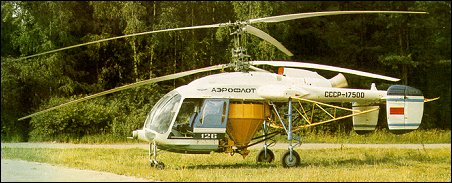
| Kamov Ka-126 project |  |
 |

| Kamov Ka-126 project |  |
 |
|
Ka-26 with engine pods removed from stub wings, fitted with one TVO-100 turboshaft engine positioned on top of fuselage, modified rotor blades, new fuel system. Prot. CCCP-01963 FF 19 Oct. 1988. Also built in Romania. Ka-128 had a 722shp Turbomeca Arriel 1D1 turboshaft. R.Simpson "Airlife's Helicopter and Rotorcraft", 1998
NATO reporting name: Hoodlum-B TYPE: General purpose light turboshaft helicopter. PROGRAMME: Development began 1984; early mockup had two small turboshafts above cabin; single turboshaft adopted subsequently; ground test vehicle completed early 1986; first flight of prototype (SSSR-01963) later 1986; first flight of first of four Soviet-built preproduction Ka-126s 19 October 1988. Proposed Ka-128, differing only in power plant and addition of an intermediate gearbox, has been abandoned. DESIGN FEATURES: Compared with Ka-26 has turboshaft engine, significant increase in payload/endurance/range, and greater year-round utilisation; updated equipment includes new low-volume spraygear. Contrarotating coaxial three-blade rotors; hinge rotor head with 'rake'-type blade attachment, to be succeeded eventually by hingeless head made of titanium and composites. Ka-26 blades of initial series to be succeeded by GFRP and CFRP blades with twin-contour spar, load-carrying rear section and electrothermal anti-icing; rotor brake standard; non-folding blades. Three-stage gearbox with planetary gear trains, of alloy steel and aluminium casting, flange mounted with four load-carrying bolts. Accessories include cooling fan, hydraulic pump and AC generator; engine input 6,000 rpm. FLYING CONTROLS: Mechanical with irreversible hydraulic actuators. Automatic rotor constant-speed control; conventional four-channel control (longitudinal, lateral, cyclic and differential pitch). Two endplate fins and rudders, toed inward 15°; non-controllable horizontal stabiliser. STRUCTURE: Airframe materials primarily aluminium alloys, steel alloys and composite sandwich panels of GFRP with honeycomb filler. LANDING GEAR: Non-retractable four-wheel type. Main units, at rear, carried by stub-wings. All four units embody oleo-pneumatic shock-absorber. Forward wheels of castoring type, self-centring, no brakes. Rear wheels have pneumatic brakes. Mainwheel tyres size 595 x 185 mm, pressure 2.45 bars; forward wheel tyres size 300 x 125 mm, pressure 3.43 bars. Skis optional. Provision for large inflatable pontoons, across front of aircraft forward of front wheels and under each mainwheel. POWER PLANT: One 522kW Mars (Omsk) TV-O-100 turboshaft, installed centrally in streamline fairing above cabin. Electronic-hydraulic automatic two-channel control system, with manual control in case of electronic governor failure. Front driveshaft with plate coupling to gearbox. Fuel in two forward and one aft tank, total capacity 800 litres. Provision for two external tanks, on sides of fuselage, total capacity 320 litres. Single-point main tank refuelling, on port side of aft tank. ACCOMMODATION: Fully enclosed cabin, with rearward-sliding door each side; normal operation by single pilot; second seat and dual controls optional. Cabin ventilated, and warmed and demisted by air from combustion heater, which also heats passenger cabin when fitted. Air filter on nose of agricultural version. Space aft of cabin, between main landing gear legs and under transmission, can accommodate variety of interchangeable payloads. Cargo/passenger pod accommodates four or six persons on folding sidewall seats, with provision for seventh passenger beside pilot; two clamshell doors at rear of pod, emergency exit each side and hatch in floor. Ambulance pod accommodates two stretcher patients, two seated casualties and medical attendant. For agricultural work, chemical hopper (capacity 1,000 litres) and dust spreader or spraybars are fitted in this position, on aircraft's CG. Aircraft can also be operated with either an open platform for hauling freight or hook for slinging loads at end of a cable or in a cargo net. SYSTEMS: Single hydraulic system, with manual override, for control actuators. Main electrical system 27V 3kW DC, with back-up 40Ah battery; secondary system 36/115V AC with two static inverters; 115/200V AC system with 16kVA generator (6kVA to power agricultural equipment and rotor anti-icing). Electrothermal rotor blade de-icing; hot air engine air intake anti-icing; alcohol windscreen anti-icing; electrically heated pitot. Pneumatic system for mainwheel brakes, tyre inflation, agricultural equipment control, pressure 39 to 49 bars. Oxygen system optional. AVIONICS: Comms: VHF and HF radio; intercom; ADF; emergency locator beacon. Jane's Helicopter Markets and Systems
|